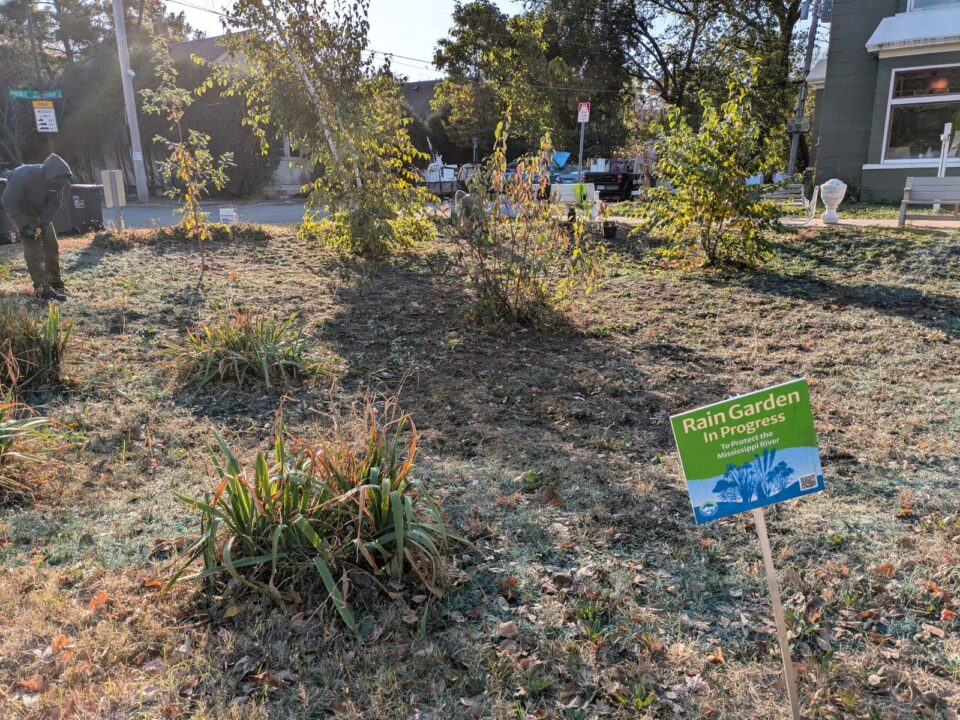Improving Rain Gardens through Pooled Maintenance
Pooled BMP Maintenance Program
Capitol Region Watershed District (CRWD) formed our new Facility Management Division in December 2023, and the division manager got to work on creating a pooled maintenance program for stormwater best management practices (BMPs) owned by public entities. As part of the program, CRWD manages maintenance for BMPs for multiple public partners, including Saint Paul Parks and Recreation, Saint Paul Public Works, the City of Falcon Heights, Roseville Area Schools, and Ramsey County. The program’s initial phase focuses on rain gardens, a common type of stormwater BMP found in many public places. Maintenance for rain gardens includes:
- Weeding
- Removing tree saplings
- Cleaning inlets from trash, sediment, and debris
- Inspecting for signs of structural problems, like erosion
The Pooled BMP Maintenance Program goals are to achieve efficient and high-quality management of rain gardens by developing one maintenance contract funded by partners that CRWD staff manages.
Rain Gardens
Rain gardens soak up and clean rainwater to help protect our lakes and the Mississippi River. The roots of native plants and soil microbes help break down pollutants in the water while it soaks deeper into the ground. Rain gardens have many great benefits, like;
- Reducing local flooding
- Reducing pollution in our lakes and rivers
- Providing habitat for pollinators
- Adding beauty with native plants and green space
However, like any infrastructure, rain gardens need to be regularly maintained, but the maintenance often requires specialized training and knowledge. Long-term maintenance is critical to ensure that projects continue to capture and clean rainwater and maximize the life of the projects.
Project Highlights
Payne Avenue
The City of Saint Paul Public Works owns a small rain garden on the corner of Payne Avenue and Preble Street, just north of Swede Hollow Park. Initially constructed in 2009, the rain garden captures water from the surrounding neighborhood.
Nearby residents have been instrumental in caring for the site and enjoy using it as an informal community park. But some areas had become weedy, and turf grass had crept in from the garden’s edges. In the fall of 2024, CRWD removed weeds, added mulch, and began restoring the garden with native plants suited to rain gardens.
Highland Bridge
Highland Bridge, the new development at the site of the former Ford Motors Assembly Plant, has five large basins and a pond. The City of Saint Paul Public Works manages the basins and the pond, totaling about two and a half acres of vegetation. The basins look like rain gardens, but there are drainage pipes and iron-enhanced sand below the plants and soil to remove dissolved phosphorus, a pollutant in the water that fuels algae growth. Iron filings mixed into sand create a bond with phosphorus, removing it from the water before it drains to the Mississippi River. Combined with other BMPs across the 122-acre site, the stormwater systems at Highland Bridge capture and clean 64 million gallons of water annually. The systems prevent an estimated 28 tons of total suspended solids and 147 pounds of phosphorus from entering the Mississippi River yearly.
Although the basins and green spaces were recently completed, weeds can quickly take over in new plantings like these. CRWD’s maintenance goals are to keep the areas looking and performing their best by controlling weeds and managing invasive species like leafy spurge, crown vetch, and Canada thistle.
Midway Peace Park
CRWD is managing vegetation at Midway Peace Park’s two rain gardens on behalf of Saint Paul Parks and Recreation. The rain gardens collect and filter 1.5 million gallons of runoff to prevent pollution from reaching the Mississippi River yearly. The gardens require close management to keep weeds like ragweed and invasive species like leafy spurge, Canada thistle and spotted knapweed from establishing and spreading.
Shared Success
These projects represent just a few examples of the numerous sites in the Pooled BMP Maintenance Program. Through the dedicated work of CRWD’s Facility Management Division, the rain gardens in this program will improve their effectiveness and extend the projects’ lifespan, saving public funds and reducing water pollution. By collaborating with multiple public agencies, we created a streamlined approach that fosters efficiency and resource sharing to maintain the beauty and function of these vital public green spaces. Thank you to our partners for their support in making our new program a success!






